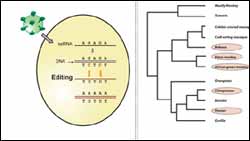HIV reveals evolution of a primate defense against intragenomic infiltrators

Antiviral editing enzymes like Apobec3G have been involved in an ancient genome defense strategy in primates <br>
Published this week on-line in PLoS Biology, Sara Sawyer, Michael Emerman, and Harmit Malik investigate the genetic roots of the battle for evolutionary advantage between HIV-type viruses and the hosts they infect. What they find is surprising.
The gene, APOBEC3G, belongs to a family of primate genes that produce enzymes (in this case, APOBEC3G) that “edit” DNA and RNA, by slipping into viral particles and inducing mutations that replace one base (cytosine) with another (uracil) as the virus undergoes reverse transcription in the host cell’s cytoplasm. The edited virus fails to replicate. HIV, in turn, generates a protein called Vif that binds to the APOBEC3G enzyme and targets it for degradation, thereby eliminating its antiviral activity.
Since the protein-binding regions that govern these interactions have a direct effect on the fitness of both virus and host, one would expect to see the proteins angling for advantage, with Vif maximizing its ability to recognize APOBEC3G and APOBEC3G doing its best to evade Vif. Such battles are thought to result in frequent mutations that alter the amino acids involved in the interaction; the perpetuation of such advantageous mutations is called positive selection.
As predicted, the APOBEC3G gene is under strong positive selection. But that selection – characterized by an analysis of twelve primates species spanning 33 million years of evolution – appears to predate the existence of HIV-type viruses. So, what has been fueling APOBEC3G’s rapid evolution?
APOBEC3G and Vif interact in T-cells, but the fact that selective pressure on APOBEC3G has been constant over the course of primate evolution suggests that another force is also acting on the gene. Sawyer et al. propose that this force is exerted by human endogenous retroviruses, which act in many ways like foreign retroviruses. These mobile genetic elements emanating from one’s own genome pose less of an immediate threat than a retrovirus like HIV. But the constant efforts of the endogenous retrovirus to “jockey for evolutionary dominance,” the authors conclude, could eventually take a toll and would be expected to provoke efforts to contain it. And it may be that this ancient intragenomic conflict endowed APOBEC3G with the means to do battle with foreign retroviruses like HIV. Therefore, despite being only recently discovered, editing of RNA and DNA may represent an ancient form of host defense in primate genomes.
Media Contact
All latest news from the category: Life Sciences and Chemistry
Articles and reports from the Life Sciences and chemistry area deal with applied and basic research into modern biology, chemistry and human medicine.
Valuable information can be found on a range of life sciences fields including bacteriology, biochemistry, bionics, bioinformatics, biophysics, biotechnology, genetics, geobotany, human biology, marine biology, microbiology, molecular biology, cellular biology, zoology, bioinorganic chemistry, microchemistry and environmental chemistry.
Newest articles

Recovering phosphorus from sewage sludge ash
Chemical and heat treatment of sewage sludge can recover phosphorus in a process that could help address the problem of diminishing supplies of phosphorus ores. Valuable supplies of phosphorus could…

Efficient, sustainable and cost-effective hybrid energy storage system for modern power grids
EU project HyFlow: Over three years of research, the consortium of the EU project HyFlow has successfully developed a highly efficient, sustainable, and cost-effective hybrid energy storage system (HESS) that…

After 25 years, researchers uncover genetic cause of rare neurological disease
Some families call it a trial of faith. Others just call it a curse. The progressive neurological disease known as spinocerebellar ataxia 4 (SCA4) is a rare condition, but its…





















